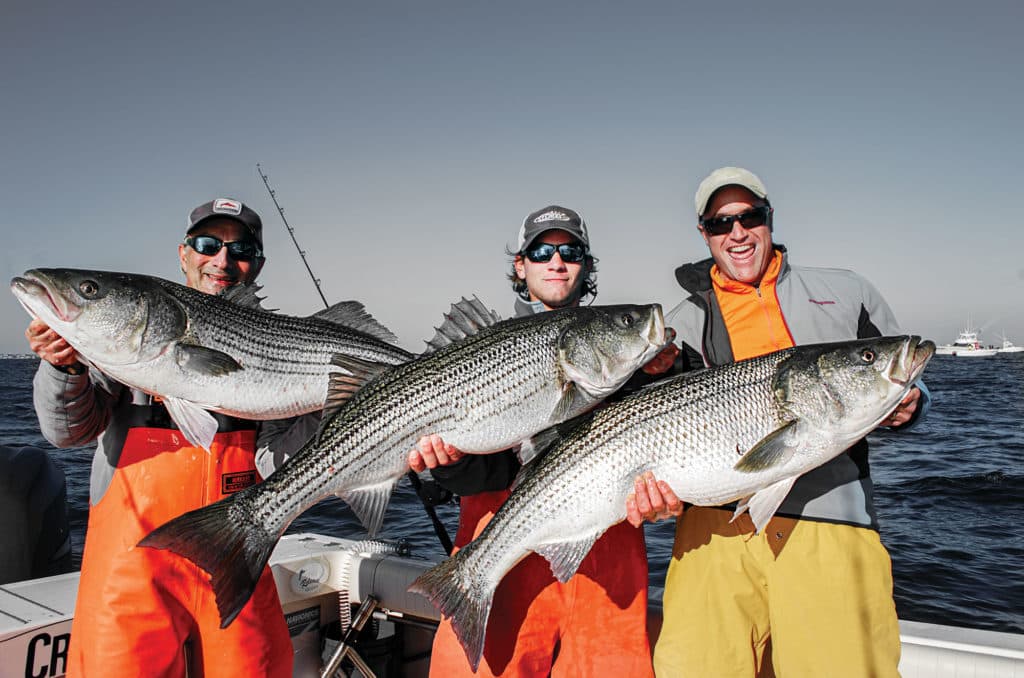
It was Saturday, April 6, 2019, and my 28 Parker Sport Cabin had been in the water for six days, ready to target the anticipated spring run of big striped bass.
That was the opening of New Jersey’s trout season, however. And honoring a family tradition, my son and first mate, Tommy, and I were there for opening day.
After the first hour of fishing, we had nothing to show. Then my son got a phone call from a buddy who mates on one of the local party boats. “Get out here now,” he said. “Big bass are everywhere.” Without hesitation, we sped to the dock, and 20 minutes later, we were smack in the middle of a major blitz of huge stripers.
The migration of big bass in our New Jersey waters begins in early April, when the first wave of fish moves in from offshore and makes a beeline for Raritan Bay.
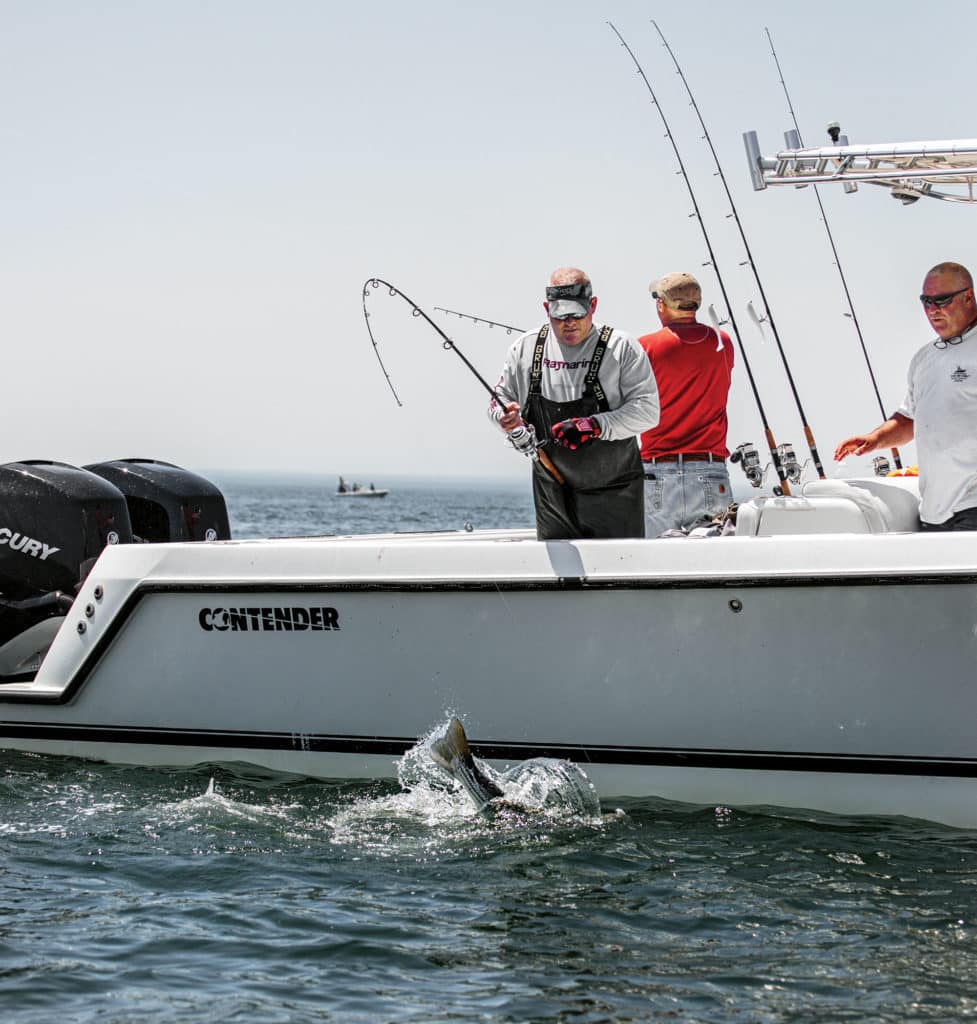
John Tiedermann, assistant dean and director of marine and environmental biology at Monmouth University in New Jersey, says: “The big bass that we see moving along the coast in early April are likely returning from their wintering grounds, and now making their way back to the Hudson River to spawn. Once spawning is completed, many of these fish disperse into Long Island Sound, New England, or northern New Jersey waters.”
Read Next: Stripers of a Lifetime in the Atlantic
This migration has been going on for millenniums. Each April, the innate drive to spawn brings this stock of anadromous striped bass into Raritan Bay, on their way up to the Hudson River to spawn in fresh water. Indicative of their pre-spawn mode, the bass feed aggressively, attacking bunker, alewife, and blueback herring in the bay.
As Tommy and I pulled up to the GPS coordinates we received, we saw birds working over a melee of bass blowing up on bunker. “Grab the surface swimmer, pal, and make a cast,” I directed. Tommy did and bam—his line came tight. I immediately grabbed a rod with a heavily weighted Tsunami Swim Shad and also hooked up at once. For two hours, we caught one big striper after another, staying with the pod as it moved toward Raritan Bay.
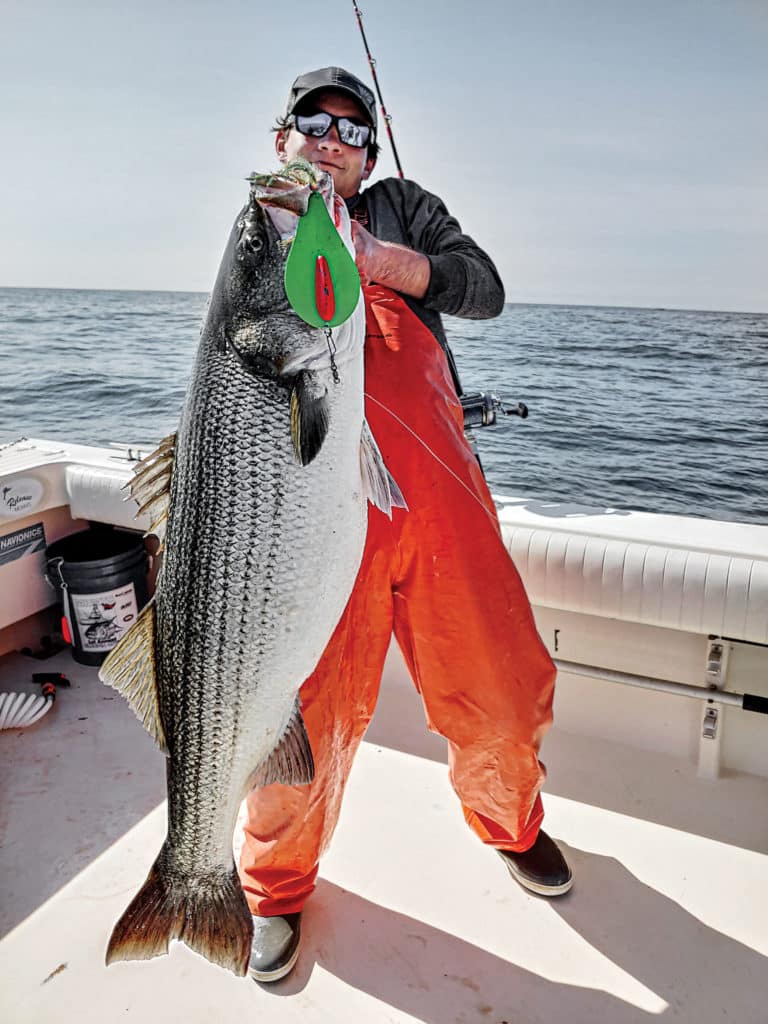
Through April, when thousands of big bass stage in the lower end of Raritan Bay, the fishing can be phenomenal. A variety of methods will produce, such as casting topwater plugs and poppers, casting weighted Tsunami Swim Shads, or trolling Mojos, for instance. So it is best to be prepared with a variety of rigged rods.
Read Next: Gear Up for Trophy Striped Bass in Chesapeake Bay
Some of the craziest days are when the wind is up and you can drift while dragging Swim Shads near the bottom, in 15 to 20 feet of water.
By May, the spawning cycle ends, and the big bass drop down the Hudson toward the ocean, to find the largest concentrations of bunker we see all season. This Hudson River stock is joined by the migrating Delaware River and Chesapeake Bay post-spawners moving north up the coast.
Tiedermann says, “During 2017 and 2018, we analyzed DNA from fin clips taken from striped bass caught in Monmouth and Ocean county waters, and determined that the majority of the fish were from the Chesapeake Bay and/or Delaware River stocks, followed by the Hudson River stock.”
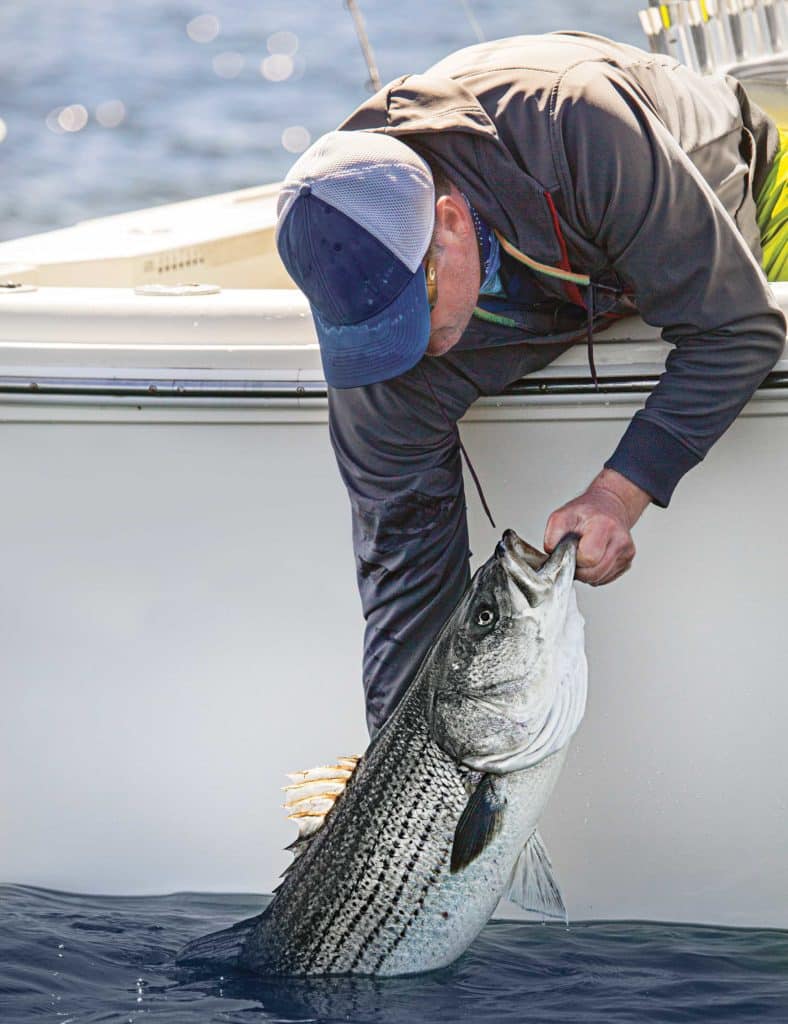
For the entire month of June, big striped bass from 40 to over 50 pounds become our targets.
Finding June bass in the bunker pods is always our main plan of attack. And first light is prime time to get on the pods, so leaving the dock at 4:30 a.m. becomes the norm.
Many mornings, I have heard Tommy yell, “A hundred yards to port, they’re blowing up.” With the conservative catch-and-release approach we practice, fishing live bunker no longer entails snag-and-drop. Instead, we snag a bunker, reel it in, and rig it on a circle hook to reduce fish mortality after the release. The hook should be placed a quarter-inch below the dorsal fin of the bunker, toward its forward section.
An alternative to snagging the baits individually is to throw a 10-foot-radius cast net with a 1-inch mesh to fill your livewell. Netted baits stay alive longer, and rebaiting to get back in the action is much faster.
When the big bass are not on the bunker pods, trolling Tony Maja No. 4 bunker spoons, in white or green, does the job. Maja says, “It is a surefire way to catch a fish of a lifetime.”
I have switched over to trolling lead-core line exclusively with my spoons because, in my opinion, it out-fishes wire or braid with trolling weights. My catches doubled when I started using lead core. It gives the spoon more action, all the better for enticing bass.
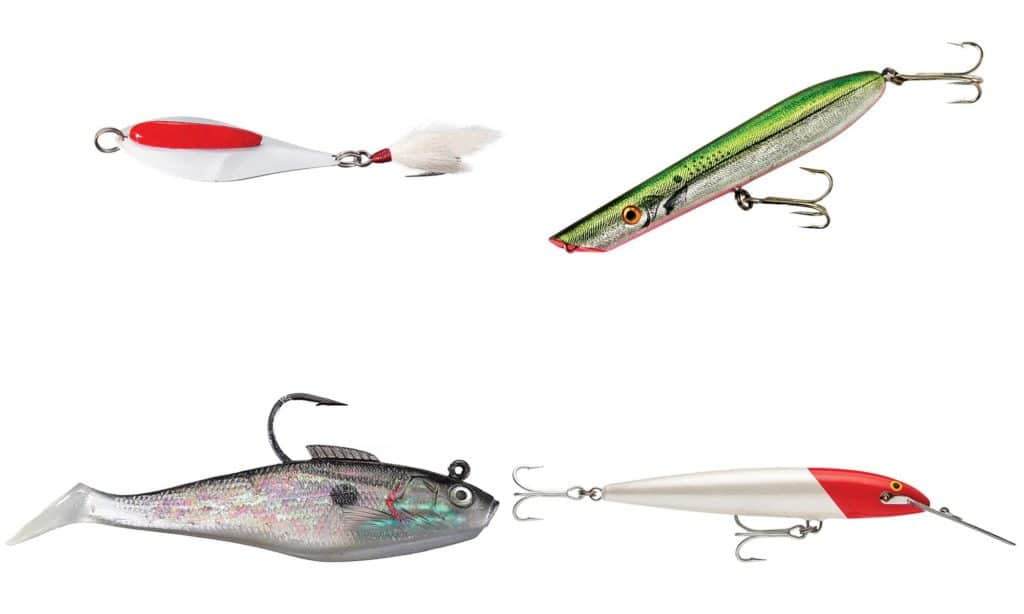
I use two Shimano Tekota 800 levelwind reels spooled with 400 feet and 350 feet of lead core, respectively, and a 25-foot, 60-pound mono leader. Put the spoon rods in the Out-Rodders, and let the lead core out until it just disappears, and you’re done. This gets one spoon down to 40 feet and the other to 35 feet. Down the center of my spread, I run a pair of 24- and 6-ounce Magic Maja Mojos Tandem Rigs off the transom.
You can also catch these 40-plus-pounders by casting lipped swimming plugs, surface poppers or pencil poppers.
I will never forget a day out with Tommy and his buddy Max a few years back, when a 25 mph northwest wind sent the bass into a feeding frenzy. Max grabbed a rod rigged with a JP Surfster swimming plug, cast into a melee, and ended up landing a 49-pounder, a trophy of a lifetime.
Top Locations for New Jersey Trophy Striped Bass
What: Trophy striped bass
When: April through June
Where: Monmouth and northern Ocean counties, Raritan Bay to Island Beach State Park, New Jersey
Who: Anglers with a desire to catch a striped bass of a lifetime. No saltwater fishing license is required, but New Jersey anglers 16 and over must be part of the NJ Saltwater Recreational Registry Program: nj.gov/dep/saltwaterregistry/index.html. Charter boats have their clients covered under their registries.
Manasquan Inlet – Shore Catch
Capt. Jim Freda Capt. Gene Quigley Capt. David Goldman 732-762-0870 shorecatch.com
Point Pleasant – Andreas’ Toy Charters
Capt. Freddy Gamboa 732-672-1561 andreastoycharters.com
Top Tackle for New Jersey Trophy Striped Bass
Rods: For live-lining: 71⁄2- to 8-foot heavy-power, fast-action conventional; for casting: 8-foot fast-action, medium-heavy spinning; for trolling: 8-foot bunker spoon rod
Reels: For live-lining: lever-drag reel or baitrunner-style spinning reels; for trolling: lead-core Shimano Tekota 800 levelwind, or equivalent
Line: For live-lining or casting: 65-pound braid and 8-foot, 40-pound fluoro leader
Lures: For trolling: No. 4 Maja spoons and Maja 24- and 6-ounce Mojos; for casting: 8- to 10-inch lipped swimming plugs, 3- to 4-ounce Pencil Poppers
Terminal Tackle: For live-lining bunker: 8/0 to 10/0 Gamakatsu circle hook; for plugs and poppers: attach to 175-pound Tactical Anglers Power Clip









